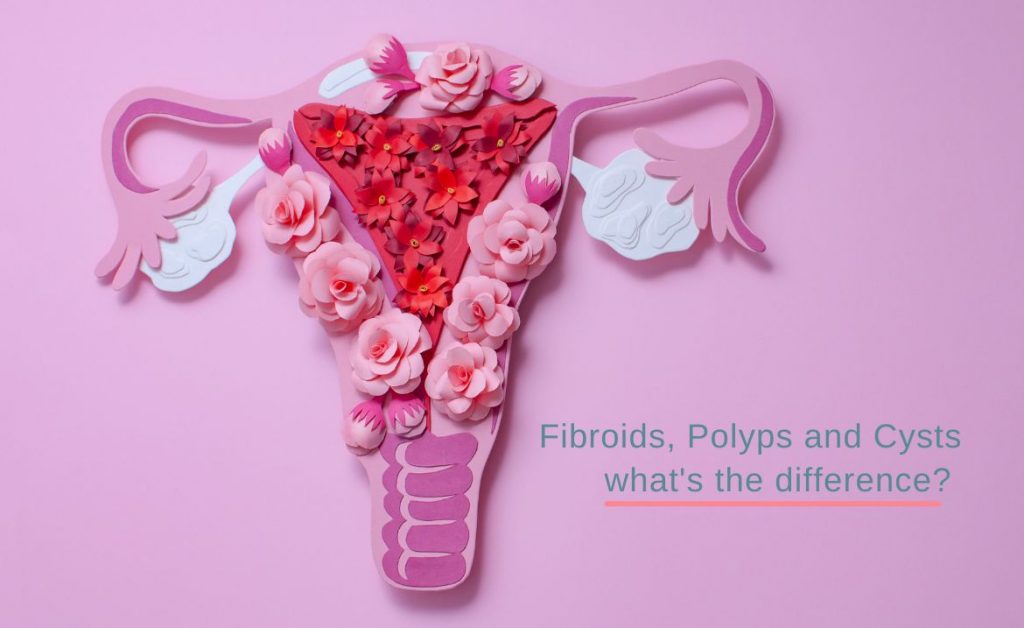Over time women may develop common gynaecological conditions such as fibroids, cysts, and polyps because of hormonal changes, the menstrual cycle, and other lifestyle factors. But with the three being so similar, you may find it difficult to differentiate between them.
To help clarify, let’s look at the main differences between the three.
The main differences between fibroids, cysts, and polyps
Fibroids
Fibroids are benign (non-cancerous) growths that can form in and around your uterus. They are common in women aged 20 and over and are usually present during reproductive age. The size and growth can vary from woman to woman but are often less than one inch to a few inches in diameter.
What causes fibroids?
Whilst it’s not clear what causes fibroids, it is possible that an imbalance in female sex hormones and genetics may play a role. Other factors that may also have an impact include
- Obesity
- A diet heavy in red meat
- Stress caused by major life events
What are the symptoms?
Often, fibroids don’t show any symptoms at all. When symptoms do occur, they depend on several factors, such as size and location. They can cause
- Heavy and painful periods
- Spotting between periods
- Difficulty passing urine or bowel movements
- Discomfort during sexual intercourse
- Infertility
If you have a larger fibroid you may experience swelling and pressure in the lower abdomen, lower back, bladder, or bowel.
How do you treat fibroids?
Generally, if the fibroids are not causing you any problems, they don’t need treatment. However, your doctor will advise on regular monitoring. Should you need treatment, the following options are available:
- Contraceptive pill: for heavy menstrual bleeding.
- Surgical treatments: depend on the severity of the symptoms, the size of the fibroids, and the location. There are two types of possible surgical treatment.
- Myomectomy: this is performed by inserting a laparoscope into the uterus through the cervix via robotic procedures or abdominal surgery. Thus, allowing the uterus to stay in place and preserving fertility.
- Hysterectomy: this surgery involves the removal of the uterus.
Polyps
A polyp is a small tissue growth caused by an abnormal growth of cells. They commonly form on the lining of the uterus and sometimes the endometrium. Polyps can also develop in other areas of the body, such as the
- Colon
- Stomach
- Bladder
- Nose
Polyps are usually benign but, in some cases, can become cancerous. They are common in women undergoing or having completed menopause.
What causes polyps?
With no specific cause, polyps are a result of the growth of abnormal cells.
What are the symptoms?
Depending on the size and location of the polyp, the symptoms will vary. While cervical polyps will not show any symptoms, uterine and endometrial polyps will cause
- Heavy menstrual bleeding
- Bleeding between periods or after sexual intercourse
- Infertility
How do you treat polyps?
Most polyps are benign (non-cancerous). But it is still recommended that you have them removed to prevent further growth and the possibility of becoming malignant.
To determine if a polyp is malignant, your doctor will remove the polyp and perform a biopsy by taking a tissue sample from the growth and sending it to a pathologist. Your doctor will remove them by performing a hysteroscopy or laparoscopy. The procedure will depend on the size and location of the polyps.
Cysts
Commonly found in younger women with regular periods, ovarian cysts are fluid-filled structures that form in the ovary and are often non-cancerous.
What causes cysts?
Many women’s health concerns may cause cysts. These include
- Hormonal issues
- Polycystic ovarian syndrome (PCOS)
- Endometriosis
- Pregnancy
- Pelvic infections
What are the symptoms?
Cysts sometimes show symptoms, including:
- Abdominal bloating
- Regular urination
- Pelvic pressure or pain
- Unusual vaginal bleeding
- Pain during sexual intercourse
If cysts break open, they can cause heavy bleeding and lead to
- Severe pain and fever
- Vomiting
- Rapid breathing
Should you experience any of the above symptoms, we advise that you seek immediate medical attention.
How do you treat cysts?
Cysts will often disappear on their own and do not need any treatment. We can manage them with regular observation. But in the occasional case that the cysts continue to grow, rupture, cause severe symptoms, or we suspect them to be cancerous, your doctor may recommend surgery.
Most commonly, your doctor will remove cysts via robotic surgery. For more complicated cases, the removal of one or both ovaries may be required – with a laparotomy (open surgery).
What to do if you suspect you have a fibroid, polyp, or cyst
If you are experiencing symptoms related to those mentioned above for fibroids, polyps, or cysts, we advise you to book an appointment with Dr Kothari.
He will carefully examine your situation, ask you about any concerns you may have, and talk to you about the most suitable treatment option for your circumstances. To book an appointment, call: 02 4225 1999

